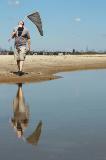
New York Conservation Summary
While the name New York is often equated with the concrete jungle of New York City, looking beyond the Big Apple reveals a remarkable diversity of natural communities and habitats throughout the state. The interplay of climate and geologic forces over millions of years has crafted the landscape into a complex array of bedrock, surficial geology, soils, landforms, and topography. These varied physical settings and their associated ecological processes support the wonderful richness of plants and animals that live in New York (State!) today.
Rare Species and Characteristic Habitats
From ocean beaches to alpine meadows, New York’s diverse habitats support an array of rare species. Long Island’s beaches provide habitat for the state-endangered piping plover and roseate tern, and two rare plant species, seabeach knotweed and the federally threatened seabeach amaranth. The mantled baskettail, a dragonfly previously known in the state only from historical records, was recently rediscovered in Long Island’s coastal plain ponds.
In southeastern New York, the Shawangunk Mountains provide habitat for more than 30 rare and endangered plants, animals, and communities that have adapted to the tough living conditions posed by the Gunks’ stark cliffs, exposed summits, and rocky plateaus. The Albany Pine Bush represents one of the best remaining examples of an inland pine barrens ecosystem in the world, and is home to two rare natural communities and 20 rare species, most notably the Karner blue butterfly.
The expansive boreal lowland spruce-fir forests of the Adirondack Mountains are home to the state-endangered spruce grouse. Alpine meadows and alpine krummholz—highly fragile communities that only exist on the highest mountaintops in the Adirondacks—support rare plants adapted to such unique environments, including diapensia, Lapland rosebay, and tufted bulrush. The limestone bedrock along Lake Ontario’s eastern shore has produced thin, seasonally dry soils, which support Alvar grassland, a globally rare natural community. This sparse landscape harbors a number of rare moths and plants, including some with Midwestern prairie affinities.
New York State is the only place on Earth where one can find the Chittenango ovate amber snail, a terrestrial snail that lives on the moist vegetated slopes in the spray zone adjacent to a waterfall in central New York. New York’s other extant endemics are two plants: the Hudson River water-nymph, a submerged aquatic plant that grows in shallow, freshwater tidal mudflats of the Hudson River, and wood reedgrass, which grows at only three known locations in eastern and central New York.
Public and Private Conservation Efforts
Conservation in New York has a strong, extensive history. A statewide natural history survey began in 1836. In 1894, the Adirondack and Catskill Forest Preserves were proclaimed in the state constitution as “Forever Wild.” At over 3 million acres, the Adirondack Forest Preserve today is the largest public wilderness area in the eastern United States.
In 1895, the Fisheries, Game, and Forest Commission was formed to conserve and manage game and fish species. The Commission evolved into the current Department of Environmental Conservation (DEC), which has further advanced conservation in the state by purchasing lands; advancing regulations that promote water and air quality, wetlands protection, and stronger environmental review; and composing the 2005 Comprehensive Wildlife Conservation Strategy.
Today, approximately 5.6 million acres are considered secured conservation lands in New York, including lands owned by the state, the federal government, county and municipal governments, and almost 800,000 acres of protected land owned by private organizations and individuals. One of the leading environmental organizations worldwide, The Nature Conservancy (TNC) established its inaugural chapter and first nature preserves in New York, and continues to be a strong presence in the state’s conservation community . In 2007, TNC purchased 161,000 acres of privately owned timberland in the Adirondack Park as part of a cooperative agreement with DEC.
Threats and Challenges
Habitat loss to residential and commercial development remains the most serious threat to species and natural communities in New York. As suburbs sprawl into new areas, habitat is fragmented, and many species are negatively affected. Habitat loss reduces the corridors between habitat patches that are essential to enable movement and avoid genetic isolation.
Another serious threat to our natural biological diversity is the spread of invasive animals and plants, which have been accidentally or intentionally introduced into our native ecosystems. Human-induced changes to the landscape have also led to native species such as white-tailed deer and red maple becoming overabundant in some areas of the state, slowly decimating and replacing our native vegetation and the animals that depend on it.
Aquatic resources are also in jeopardy. Eight native mussels are listed as state endangered or threatened, due primarily to human-caused changes to hydrology, substrate, and water quality. Aquatic plant diversity is threatened by the rise and spread of invasives which out-compete and displace native species. Acid rain threatens lakes of the Adirondacks, which lack buffering capacity and whose aquatic life cannot tolerate the increase in acidity.
Climate change is our most recent conservation challenge, and for some of the ecosystems in New York it may have the greatest long-term impact. Sea-level rise may already be a factor in the decline of some tidal salt marsh systems on Long Island. Alpine habitats in the Adirondacks may be affected as temperatures increase and lower-elevation species climb farther up the mountains. We may lose some occurrences of summit communities altogether as they run out of room to climb.
New York’s Future
The conservation challenge for New York is to protect and properly manage enough open space, native ecosystems, and habitats to counter the effects of development pressure and invasive species and to accommodate future shifts in species distributions due to climate change. While the long-term impacts of climate change may well lead to losses and additions to the state’s resident plants, animals, and natural communities, the overall measure of our success will be whether the lives of future generations in New York will still be enriched by a rich and wonderful diversity of life.







